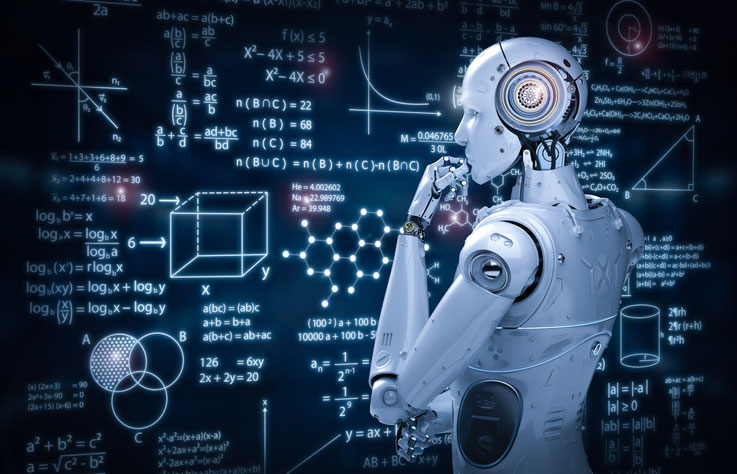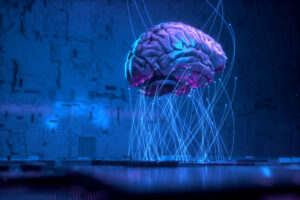Written by Scott Wilson
Machine learning is a set of techniques that have come from the larger study of artificial intelligence. They use algorithms to allow machines to process and draw conclusions from data and build models that allow them to independently predict and infer new information without additional human instruction.

It’s rare to see the term artificial intelligence today without finding machine learning somewhere within a paragraph or two.
Yet before AI was the next big thing, ML was already there.
AI and machine learning have a complex relationship going back decades.
Featured Programs:Sponsored School(s) Arizona State University - OnlineFeatured Program: Artificial Intelligence in Business, BS
Arizona State University - OnlineFeatured Program: Artificial Intelligence in Business, BS Campbellsville UniversityFeatured Program: MS in Data Science and Artificial Intelligence
Campbellsville UniversityFeatured Program: MS in Data Science and Artificial Intelligence George Mason UniversityFeatured Program: MSAIT - Machine Learning Engineering Concentration
George Mason UniversityFeatured Program: MSAIT - Machine Learning Engineering Concentration

Although the two subjects have traveled long, strange paths to get to where they are today in the technology pantheon, those paths are inextricably intertwined.
The Best Machine Learning Definition May Come from Pop Culture
 ML is a computational technique that is part of the AI toolkit. It describes the creation of algorithms that can iterate through data and adapt themselves to the details as they go… precisely what we would describe in humans as learning from new information. It leads to new conclusions and insights, and it does it at the speed of some of the fastest computers on the planet.
ML is a computational technique that is part of the AI toolkit. It describes the creation of algorithms that can iterate through data and adapt themselves to the details as they go… precisely what we would describe in humans as learning from new information. It leads to new conclusions and insights, and it does it at the speed of some of the fastest computers on the planet.
The canonical pop culture reference for machine learning is the ending of the ‘80s classic hacker movie War Games. The American military has handed the keys to the nuclear arsenal over to an advanced, integrated supercomputer named WOPR…
Through a few mis-steps committed while breaking into the WOPR over the phone (via a 1200 baud modem, if you happen to know what that is), our hero David Lightman (played by Matthew Broderick, if you happen to know who he is) has set WOPR on a path to launch a preemptive nuclear strike on the Soviet Union (if you remember what that was).
As WOPR rapidly sets about cracking the security keys to the launch codes, Lightman has a flash of insight on how to show the computer that there can be no winner in such a war. He sets up a game of tic-tac-toe, the quintessential un-winnable game. Then he tells WOPR to play against itself.
At blinding speeds, WOPR plays every combination, then rapidly moves on to more advanced war simulations, which are just as futile. Only seconds before launch, it stops.
“A strange game. The only winning move is not to play,” it concludes.
Without anyone telling it directly, WOPR taught itself an important lesson about the world. Somewhere behind all the flashing lights and spinning reel-to-reel tapes, software shifted its own bits. An inference was made; a generalization happened. A conclusion was reached.
That’s exactly where the technique of machine learning is headed today.
Most of the Biggest Breakthroughs in AI Today Have Come Through Machine Learning
 While there are no WOPR-grade connections occurring in AI systems yet, there are miracles of creation happening right out where anyone can see them. AI chatbots capable of weaving words at the level of the most capable human writers can carry on conversations rooted in ML-generated neural networks. Image generators combine the same kind of natural language processing with deeply trained algorithmic transformers to create fabulous and lifelike pictures.
While there are no WOPR-grade connections occurring in AI systems yet, there are miracles of creation happening right out where anyone can see them. AI chatbots capable of weaving words at the level of the most capable human writers can carry on conversations rooted in ML-generated neural networks. Image generators combine the same kind of natural language processing with deeply trained algorithmic transformers to create fabulous and lifelike pictures.
In more serious fields, machine learning algorithms are trained to:
- Spot tumors in MRI scans
- Assemble model proteins at blinding speeds to identify new therapies and compounds for medicines
- Pilot cars with more precision and safety than human drivers
If you’re looking for ways in which AI will change the world, you usually don’t have to look any further than the latest developments in machine learning.
What Exactly Is an Algorithm?
 An algorithm is just a set of instructions to follow to accomplish a specific task. Even humans can execute the simplest algorithms… a five-year-old can execute a credible bubble sort on a deck of playing cards.
An algorithm is just a set of instructions to follow to accomplish a specific task. Even humans can execute the simplest algorithms… a five-year-old can execute a credible bubble sort on a deck of playing cards.
Machine learning uses the power of computers to crack vastly more difficult problems. But designing the algorithms is the real magic.
An in-depth knowledge of algorithm design and execution is a must-have in AI studies today. Algorithms at heart can be very simple sets of instructions. They’ve been a mainstay in computer science since the earliest days, when the most efficient recipes for sorting, comparing, and otherwise manipulating data became codified to the point where many programmers could implement them by heart.
The optimal answers came from math and an understanding of the underlying binary language of digital computers. The sets of steps to derive an answer and how long they needed to execute were rooted in:
- Flow control, or the order of computation
- Size, or the number of steps required to derive an answer
- Methods of computation, or the precise machine instructions needed to execute each step of the algorithm
With the advent of machine learning, though, breaking down the pieces of algorithm design and implementation has become even more important. Today, programmers are teaching computers to teach themselves the most efficient algorithms.
This is such an exciting and promising field for AI because the speed of computation is such that a machine can test many possible paths to implement an algorithm rapidly. There’s every reason to think they can code themselves to levels of performance that would take humans decades to achieve, if ever.
What Is Machine Learning in Relation to Artificial Intelligence?
The field of artificial intelligence has gone through a long, slow climb to today’s headlines. It’s been a boom-and-bust cycle of excitement and research funding, followed by derision and neglect.
Each time artificial intelligence research busted out, it left a little piece of important accomplishment on the doorstep of computer science.
In the first surge of interest in the ’40s and ‘50s when scientists began looking at ways in which machines might be made to think as humans, one of the concepts developed was self-teaching computers. New breakthroughs in the understanding of the human brain, and the action of neural structures in cognition led to attempts to replicate similar networks in programming.
Machine learning was born.
AI took a different direction, and then crashed after a series of theoretical roadblocks emerged in the late ‘60s. But ML, which was rooted in statistical methods, flourished in pattern recognition and information analysis.
The Definition of Machine Learning Is Shifting as AI Comes into Focus Again
 During those years, when the research and corporate worlds banished the field of AI to the cellar, ML found life as a key component in data science.
During those years, when the research and corporate worlds banished the field of AI to the cellar, ML found life as a key component in data science.
Data science is an outgrowth of the fields of computer science and statistics. It was designed to explore and find knowledge in very large, cluttered, or poorly defined data sets. Looking back, it’s easy to see how extracting meaning from those kinds of data is in fact a kind of artificial intelligence.
Today, some people are shifting the definition of the field of data science itself back into the big tent of artificial intelligence.
For years, ML was most closely associated with data science. As data scientists became more and more important in business in every industry, machine learning degrees and certificates popped up aimed almost entirely at applying ML to problems of statistical analysis.
Yet at the same time, the field was evolving to the point where stats and data could be used to create generative models of analysis useful in AI. Statistics are at the core of what drives a modern chatbot or image generator. As researchers explore further down the path of what it means to be intelligent and how machines can be taught to behave with reason, it seems clear that statistics will play a big role… which is what brings machine learning right back to AI again.
As both AI and machine learning continue to evolve, you’re likely to see definitions shift again and again. As new techniques are developed, and new uses are discovered, the ideas of both ML and AI may bounce around in both pop culture and computer science.
How Does Machine Learning Work?
 The basis of all machine learning is in developing a mechanism by which programs can accept information and draw conclusions from it. Beyond that, there are a dozen techniques that work in different ways to reduce data sets, generalize their contents, and create statistical models to use for generation or classification of future data.
The basis of all machine learning is in developing a mechanism by which programs can accept information and draw conclusions from it. Beyond that, there are a dozen techniques that work in different ways to reduce data sets, generalize their contents, and create statistical models to use for generation or classification of future data.
The basis for most of those ML techniques is carefully crafted algorithms that recursively examine the information and give the machine guidance on how to process it. While the systems are adaptive, optimizing their own algorithmic brains on the fly, they still must be told in some way what they are supposed to be optimizing for.
That guidance can come through three basic paths:
Supervised Learning
Supervised learning uses training data labeled with examples of the categories of information the algorithm should learn. With iterations over the data, the algorithm has results that it can compare to the training labels. At some point, it will find some optimal way to classify information in line with the examples it was given.
Supervised learning is used heavily in applications where a set of data is known and has well-defined features. It is used heavily in ranking and recommendation systems and voice and facial recognition. Since it is identifying a known item, a high degree of reliability can be achieved.

Unsupervised Learning
Unsupervised learning, as you might guess, works without labels in the training data. Instead, the algorithm is designed to identify commonalities in that data. The common points can occur in any way that the algorithm can find to discriminate between differences. This can lead to unexpected classifications that humans might never identify—a feature that can deliver either amazing results or complete failure.
This type of ML is most useful in exploring data sets with unknown or poorly understood boundaries and relationships. Vast streams of IoT (Internet of Things), meteorological, or financial data are too much for any human to evaluate in a reasonable timeframe, even with machine assistance. But unsupervised ML algorithms can chew through that data and find underlying patterns with ease.
Reinforcement Learning
Reinforcement learning uses programmed reward functions to push algorithms to find an optimal balance between exploration and playing it safe when finding solutions. It’s a powerful technique since it doesn’t require labeled training data (as supervised learning does) but can identify significance in patterns rather than just patterns themselves (which unsupervised learning cannot). However, it’s a more complex process to design and balance.
These types of ML algorithms are key in artificial intelligence development. They push the boundary between exploring and exploiting information… a very similar pattern to how human intelligence evaluates and interprets the environment.
There are various combinations, subsets, and methodologies associated with these techniques. They can be combined and crossed over for different purposes. But the focus remains similar: creating a set of instructions that enable a machine to reason through the data that is presented.
To Define Machine Learning’s Contribution to AI, You Can Look to Artificial Neural Networks
Machine learning describes a basic family of computational and training techniques. As you’ve seen, it can be applied to a number of different kinds of information and logic problems.
Machine learning is a foundational technology for AI, but it’s really the castles built on those foundations that are the jewels in today’s artificial intelligence crown.
For the most part, the systems that ML has helped build come through a specific application of the technique called deep learning, which is used to build artificial neural networks.
Deep learning refers to the depth of algorithmic processing that is being used. Researchers realized that rather than relying on a single, complex algorithm layer to process information, a series of single-purpose filters could be used. This concept resembles the way that biological neural networks were thought to function, with millions of simple neurons either firing or not, coming together to interpret complex information coursing through the brain.
Artificial neural networks built using deep learning is the end goal of most machine learning in AI today. While the idea for such systems has been around for a long time, the computational ability to put together millions of layers and process billions of datapoints to train them has only recently emerged. So far, it’s been the most impressive approach to building thinking machines.
What Are the Alternatives to Machine Learning?
 Machine learning is seen as almost synonymous with AI today because the technique has found such success in processing and interpreting ambiguous data… which is mostly what the real world has to offer.
Machine learning is seen as almost synonymous with AI today because the technique has found such success in processing and interpreting ambiguous data… which is mostly what the real world has to offer.
But for many decades, before computer processing and data storage had a chance to catch up to the promise of neural networks and probabilistic reasoning, other approaches to AI were thought to be more favorable.
Many early AI scientists pursued symbolic artificial intelligence systems. These were more straightforward implementations of logical rule-based systems, using big databases full of answers and straightforward IF/THEN reasoning. But they performed poorly addressing new and unknown types of problems or ones without definitive answers.
Other approaches include evolutionary algorithms, which use evolutionary metaphors to optimize performance, and situational approaches which build simple behaviors into small subsystems to create emergent intelligence through environmental interaction.
Symbolic AI doesn’t involve machine learning since the rules of the system are hardcoded as it is built. Some of the other approaches could, in a sense, be defined as machine learning since they involve adaptive reasoning over time. But as a practical matter, most people don’t include them in the machine learning definition in use today.
Other types of machine learning algorithms, such as linear or logistic regression, clustering, or Bayesian networks are also used in special purpose AI, however. And research continues to find new methods and new ways to use existing methods to create reasoning machines.
That means that machine learning will continue to be a hot field and a key piece of AI engineering for decades to come.











